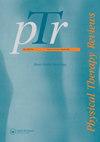The effects of epidural stimulation on individuals living with spinal cord injury or disease: a scoping review
IF 0.8
Q4 REHABILITATION
引用次数: 1
Abstract
Abstract Background Spinal cord injury/disease (SCI/D) impacts sensory, motor and autonomic function. Epidural stimulation (ES) has the potential to improve function across many domains. Objective To synthesize the effects of ES on functional goals for individuals with SCI/D. Methods Seven biomedical databases were searched. Inclusion criteria required (1) ES as the primary intervention, (2) human participants with SCI/D, (3) pre-post measure of an orthotic and/or therapeutic effect, and (4) original data. Data extracted were participant characteristics, ES and exercise parameters, outcome measures, complications, orthotic and/or therapeutic effects. Data were synthesized descriptively according to functional goal. Critical appraisal was completed using the Downs and Black modified checklist. Results Included studies were case studies or case-series (n = 24), or pre-post interventions (n = 23). One study was a case-control. Research quality was poor to fair. There were mixed results of ES on bladder and sexual function, and standing in participants with SCI/D. Effects of ES included improved bowel function, increased cardiorespiratory and cardiometabolic function, pain reduction, decreased spasms and spasticity, and, when combined with repetitive movement training, improved gait parameters. In the one study focused on the upper extremity, grip strength improved. Conclusions ES shows promise as an intervention to improve functional goals after SCI/D with a focus on locomotion.硬膜外刺激对脊髓损伤或疾病患者的影响:范围界定综述
摘要背景脊髓损伤/疾病(SCI/D)影响感觉、运动和自主神经功能。硬膜外刺激(ES)具有改善多个领域功能的潜力。目的综合ES对SCI/D患者功能目标的影响。方法检索7个生物医学数据库。纳入标准要求(1)ES作为主要干预,(2)SCI/D的人类参与者,(3)矫正和/或治疗效果的前后测量,以及(4)原始数据。提取的数据包括参与者特征、ES和运动参数、结果测量、并发症、矫正和/或治疗效果。根据功能目标对数据进行描述性综合。使用Downs和Black修改的检查表完成了关键评估。结果纳入的研究为病例研究或病例系列(n = 24),或前后干预(n = 23)。其中一项研究是病例对照研究。研究质量参差不齐。ES对SCI/D参与者的膀胱和性功能以及站立的影响结果喜忧参半。ES的效果包括改善肠功能、增强心肺和心脏代谢功能、减轻疼痛、减少痉挛和痉挛,以及在与重复运动训练相结合时改善步态参数。在一项针对上肢的研究中,握力得到了改善。结论ES有望作为改善SCI/D后功能目标的干预措施,重点关注运动。
本文章由计算机程序翻译,如有差异,请以英文原文为准。
求助全文
约1分钟内获得全文
求助全文
来源期刊

Physical Therapy Reviews
REHABILITATION-
CiteScore
1.30
自引率
0.00%
发文量
26
期刊介绍:
Physical Therapy Reviews is an international journal which aims to publish contemporary reviews, discussion papers and editorials within physical therapy, and in those basic and clinical sciences which are the basis of physical therapy. The journal is aimed at all those involved in research, teaching and practice within the area of physical therapy. Reviews (both descriptive and systematic) are invited in the following areas, which reflect the breadth and diversity of practice within physical therapy: •neurological rehabilitation •movement and exercise •orthopaedics and rheumatology •manual therapy and massage •sports medicine •measurement •chest physiotherapy •electrotherapeutics •obstetrics and gynaecology •complementary therapies •professional issues •musculoskeletal rehabilitation
 求助内容:
求助内容: 应助结果提醒方式:
应助结果提醒方式:


